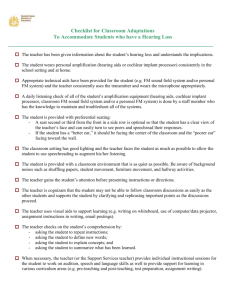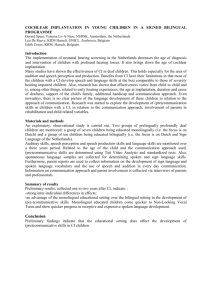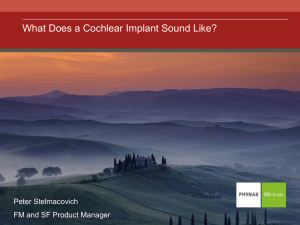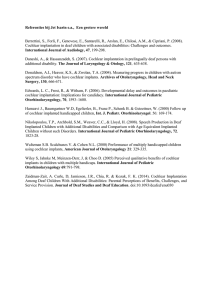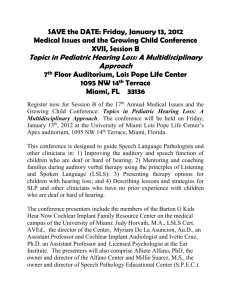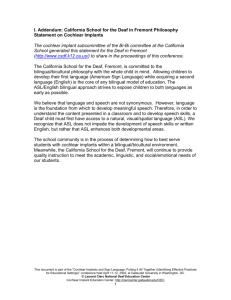Affordable Care - American Cochlear Implant Alliance
advertisement
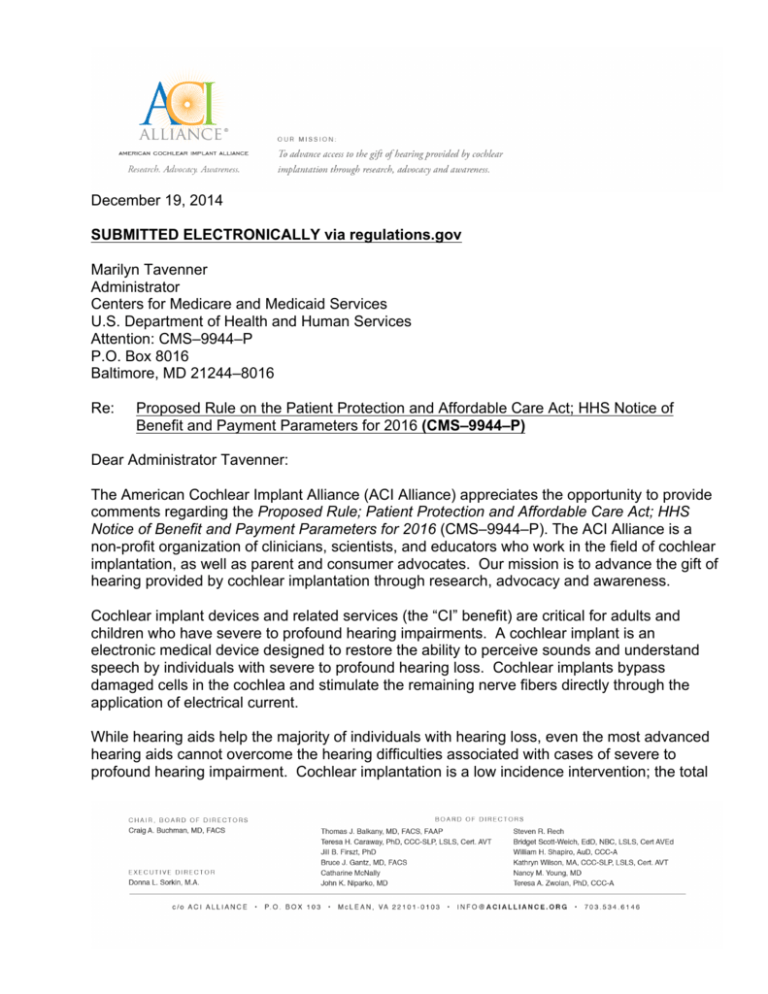
December 19, 2014 ! SUBMITTED ELECTRONICALLY via regulations.gov Marilyn Tavenner Administrator Centers for Medicare and Medicaid Services U.S. Department of Health and Human Services Attention: CMS–9944–P P.O. Box 8016 Baltimore, MD 21244–8016 Re: Proposed Rule on the Patient Protection and Affordable Care Act; HHS Notice of Benefit and Payment Parameters for 2016 (CMS–9944–P) Dear Administrator Tavenner: The American Cochlear Implant Alliance (ACI Alliance) appreciates the opportunity to provide comments regarding the Proposed Rule; Patient Protection and Affordable Care Act; HHS Notice of Benefit and Payment Parameters for 2016 (CMS–9944–P). The ACI Alliance is a non-profit organization of clinicians, scientists, and educators who work in the field of cochlear implantation, as well as parent and consumer advocates. Our mission is to advance the gift of hearing provided by cochlear implantation through research, advocacy and awareness. Cochlear implant devices and related services (the “CI” benefit) are critical for adults and children who have severe to profound hearing impairments. A cochlear implant is an electronic medical device designed to restore the ability to perceive sounds and understand speech by individuals with severe to profound hearing loss. Cochlear implants bypass damaged cells in the cochlea and stimulate the remaining nerve fibers directly through the application of electrical current. While hearing aids help the majority of individuals with hearing loss, even the most advanced hearing aids cannot overcome the hearing difficulties associated with cases of severe to profound hearing impairment. Cochlear implantation is a low incidence intervention; the total ! number of cochlear implant recipients in the United States in 2012 was estimated at 96,000 children and adults.1 There are stringent standards for who may receive a cochlear implant. Determination of candidacy is made by a team including an otolaryngologist and audiologist specializing in cochlear implantation. Testing for candidacy is completed in “best aided condition,” meaning the patient must be unable to receive sufficient meaningful sound when wearing well-fit and appropriate hearing aids. Therefore, there is no meaningful alternative to CI. Cochlear implants are covered by over 90% of commercial health plans because the CI benefit is life-changing and cost effective. Typical coverage includes evaluation, surgery, the CI device itself, programming, and habilitation/rehabilitation needed to optimize outcomes with the intervention. Cochlear implants are also covered by Medicare and by all state Medicaid plans for children. Some state Medicaid plans also cover for adults. Cochlear implants, coupled with intensive post-implantation therapy, can help young children to acquire speech, language, and literacy skills. Many deaf children who receive cochlear implants are able to attend mainstream schools and perform academically on par with their peers. The CI benefit enables adults who have congenital or acquired severe-to-profound hearing loss to remain self-sufficient and in the workforce. For young adults, the cochlear implant can provide decades of benefit for those seeking to advance their careers or employment options. Seminal research demonstrated that the cost savings to society when a young child receives a cochlear implant exceeds $1 million.2 Cost effectiveness of CI has also been confirmed in adults of all ages.3 The ACI Alliance recognizes the need for HHS to further clarify the definition of the habilitation and rehabilitation services and devices essential health benefit (EHB). Given that appropriate and adequate coverage of the CI benefit could make a critical difference to the lives of individual Americans with severe to profound hearing impairment; the ACI Alliance recommends the following for inclusion in the final rule. Defining Habilitation and Rehabilitation Services and Devices Habilitative and rehabilitative services and devices encompass a wide range of benefits critical to individuals with injuries, illnesses, disabilities and chronic conditions. These services and !!!!!!!!!!!!!!!!!!!!!!!!!!!!!!!!!!!!!!!!!!!!!!!!!!!!!!!! 1!NIDCD,!NIH!website,!http://www.nidcd.nih.gov/health/hearing/pages/coch.aspx.!Retrieved!12/18/2014. ! 2!Cheng et al. Cost-utility of the cochlear implant in children, JAMA 2000 Aug;204(7):851-6.! HW. Impact of cochlear implants on the functional health of older adults, Larynoscope 2002 (Aug; 112(8Pt1):1482- 3!Francis 8.! ! ! devices are provided by appropriately credentialed (licensed, accredited and certified) providers and suppliers. The habilitation benefit is critical for children with severe to profound hearing impairments who receive cochlear implants. As many as 40% of children with hearing loss have other disabilities4. Recognizing these diverse developmental needs is important and must be closely monitored in conjunction with appropriate support to meet the child’s specific needs—both for his hearing loss and other concerns. Because we are now implanting children at one year of age, these developmental issues may not become apparent until the child is older. Some considerations in the “deaf plus” child include autistic spectrum disorder, cerebral palsy and sensorimotor integration challenges.5 Children with other needs will require specialized therapy that addresses the hearing loss alongside of the other disability. The term “habilitative services” regularly pertains to health care services and devices that are designed to assist individuals in acquiring or improving, partially or fully, skills and functioning for daily living. These services may include physical therapy, occupational therapy, speechlanguage pathology and audiology, and other services and devices for people with disabilities in a variety of inpatient and/or outpatient settings. Minimum Standard of Coverage for Habilitation and Rehabilitation Services and Devices ACI Alliance recommends that HHS state in its final rule that in order to meet the minimum definition of habilitation and rehabilitation services and devices used by States and health plan issuers, a plan must: • Cover habilitation and rehabilitation by permitting flexibility in benefit design to accommodate those who need additional therapy to achieve medically necessary, therapeutic goals. The benefit should have allowances for extra contracted services and include access to various therapy types; • Cover habilitation in a way that allows separate and distinct visit limits from other EHBs. Habilitation visit limits must be based upon medical need and not set at a standardized number (i.e., a child who is deaf and who, through the use of CI, is learning to hear and speak for the first time would need a certain level of habilitation services, as opposed to !!!!!!!!!!!!!!!!!!!!!!!!!!!!!!!!!!!!!!!!!!!!!!!!!!!!!!!! 4!!Perigoe CB & Perigoe R. Multiple Challenges—Multiple Solutions: Children with Hearing Loss and Special Needs. The Volta Review, V104, No 4, 2004. 5 Ellis Jill. Meeting Early Education Needs of Deaf Children with Additional Medical Needs and Developmental Delays. CI2013 Symposium Proceedings. Cochlear Implants International, V15, No 5, 2014. ! the adult who regains hearing and will need a different intensity of rehabilitation services than the child).6 As part of early prevention, at a minimum, habilitation should be made available to children less than three years old with no caps on therapy. • Prohibit unreasonable and arbitrary visit and dollar limits on a specific category of benefits resulting in a condition-based exclusion or condition-based limits. For example, health plans should not set condition-specific medical device exclusions. In the same manner, plans should not place arbitrary limits on devices which prevent a patient from receiving the accepted and recognized standard of care appropriate for that benefit. For example, limiting a device benefit to one device per year would prevent a child with profound hearing impairment from receiving bilateral cochlear implants, which are now the standard of care for children with profound hearing loss to allow them to develop language that is as close as possible to that of their typically hearing peers; • Cover device maintenance, including replacement batteries and long-term maintenance of external devices even after a device warrantee runs out. With regard to CI, the replacement of processors is a prime example of the need for the coverage of device maintenance; • Prohibit defining the benefits in such a way as to exclude coverage for services and devices based upon age, disability or expected length of life, such as designing a benefit to exclude services for adults or children who are deaf or hard of hearing; and, • Prohibit the use of cost-sharing requirements or utilization management techniques that are more restrictive on habilitation and rehabilitation services and devices than they are on all other EHB benefits. ! As CMS establishes a uniform minimum definition of habilitative and rehabilitative services and devices that may be used by States and health plan issuers, the ACI Alliance reminds HHS that cochlear implantation and intensive post-implantation therapy is covered by the “typical employer plan,” the standard for coverage in the Affordable Care Act. Similarly, coverage of cochlear implants and intensive therapy post-implantation, under the category of habilitative and rehabilitative services and devices, should be clearly defined as a benefit within a qualified health plan’s EHB package. !!!!!!!!!!!!!!!!!!!!!!!!!!!!!!!!!!!!!!!!!!!!!!!!!!!!!!!! 6!The!amount!and!duration!of!therapy!required!will!vary!depending!upon!the!age!of!the!individual!receiving!the! cochlear!implant,!the!individual’s!amount!of!residual!hearing!at!the!time!of!the!implant,!the!individual’s!ear! anatomy,!and!other!complicating!health!factors!such!as!cognitive!impairment,!blindness,!or!Cerebral!Palsy,!to! name!a!few!conditions!that!are!known!to!occur!with!deafness.!Clinicians!must!have!the!ability!to!set!the!amount!of! benefit!provided;!arbitrary!limits!set!by!the!plan!could!prohibit!the!individual!from!receiving!meaningful!benefit! from!the!intervention,!and!could!severely!limit!the!costOeffectiveness!of!the!intervention. ! For more information on cochlear implantation, please visit www.ACIAlliance.org or contact Donna Sorkin, Executive Director via email at: DSorkin@acialliance.org. Thank you for your consideration of my comments. Sincerely, ! Donna Sorkin Executive Director American Cochlear Implant Alliance !
